radiator JEEP GRAND CHEROKEE 2013 Owner handbook (in English)
[x] Cancel search | Manufacturer: JEEP, Model Year: 2013, Model line: GRAND CHEROKEE, Model: JEEP GRAND CHEROKEE 2013Pages: 408, PDF Size: 3.21 MB
Page 251 of 408
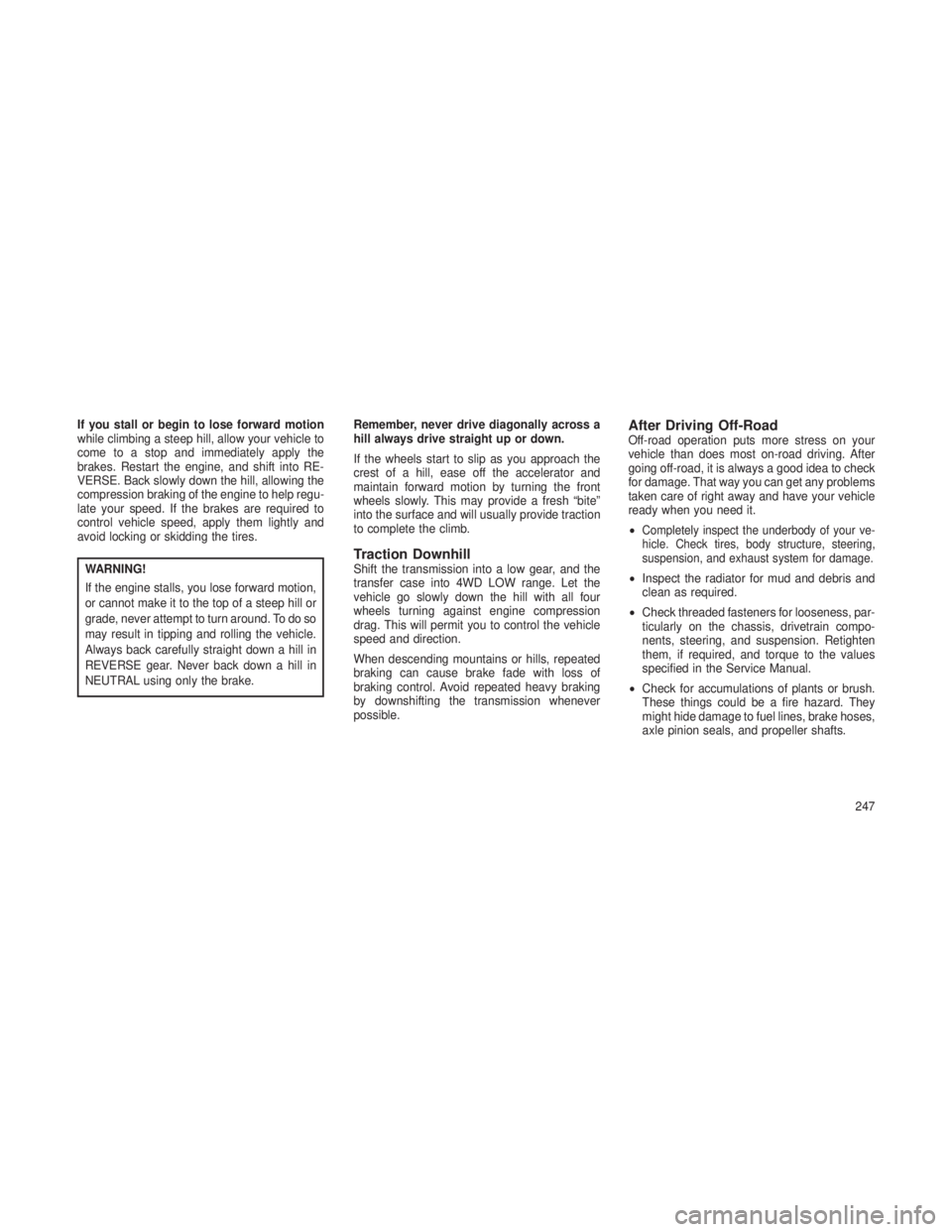
If you stall or begin to lose forward motion
while climbing a steep hill, allow your vehicle to
come to a stop and immediately apply the
brakes. Restart the engine, and shift into RE-
VERSE. Back slowly down the hill, allowing the
compression braking of the engine to help regu-
late your speed. If the brakes are required to
control vehicle speed, apply them lightly and
avoid locking or skidding the tires.
WARNING!
If the engine stalls, you lose forward motion,
or cannot make it to the top of a steep hill or
grade, never attempt to turn around. To do so
may result in tipping and rolling the vehicle.
Always back carefully straight down a hill in
REVERSE gear. Never back down a hill in
NEUTRAL using only the brake.Remember, never drive diagonally across a
hill always drive straight up or down.
If the wheels start to slip as you approach the
crest of a hill, ease off the accelerator and
maintain forward motion by turning the front
wheels slowly. This may provide a fresh “bite”
into the surface and will usually provide traction
to complete the climb.Traction DownhillShift the transmission into a low gear, and the
transfer case into 4WD LOW range. Let the
vehicle go slowly down the hill with all four
wheels turning against engine compression
drag. This will permit you to control the vehicle
speed and direction.
When descending mountains or hills, repeated
braking can cause brake fade with loss of
braking control. Avoid repeated heavy braking
by downshifting the transmission whenever
possible.
After Driving Off-RoadOff-road operation puts more stress on your
vehicle than does most on-road driving. After
going off-road, it is always a good idea to check
for damage. That way you can get any problems
taken care of right away and have your vehicle
ready when you need it.
•
Completely inspect the underbody of your ve-
hicle. Check tires, body structure, steering,
suspension, and exhaust system for damage.
•
Inspect the radiator for mud and debris and
clean as required.
• Check threaded fasteners for looseness, par-
ticularly on the chassis, drivetrain compo-
nents, steering, and suspension. Retighten
them, if required, and torque to the values
specified in the Service Manual.
• Check for accumulations of plants or brush.
These things could be a fire hazard. They
might hide damage to fuel lines, brake hoses,
axle pinion seals, and propeller shafts.
247
Page 298 of 408
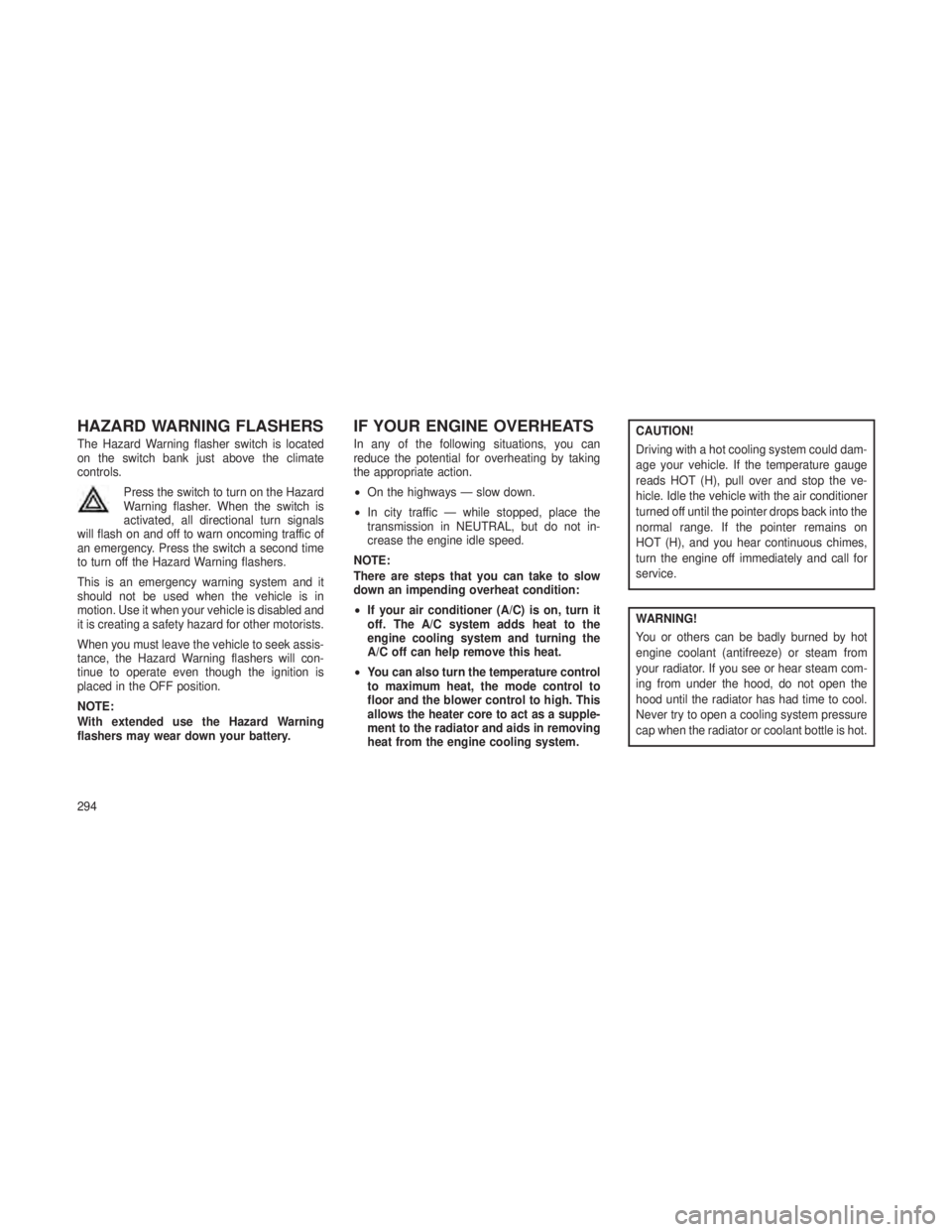
HAZARD WARNING FLASHERS
The Hazard Warning flasher switch is located
on the switch bank just above the climate
controls.Press the switch to turn on the Hazard
Warning flasher. When the switch is
activated, all directional turn signals
will flash on and off to warn oncoming traffic of
an emergency. Press the switch a second time
to turn off the Hazard Warning flashers.
This is an emergency warning system and it
should not be used when the vehicle is in
motion. Use it when your vehicle is disabled and
it is creating a safety hazard for other motorists.
When you must leave the vehicle to seek assis-
tance, the Hazard Warning flashers will con-
tinue to operate even though the ignition is
placed in the OFF position.
NOTE:
With extended use the Hazard Warning
flashers may wear down your battery.
IF YOUR ENGINE OVERHEATS
In any of the following situations, you can
reduce the potential for overheating by taking
the appropriate action.
• On the highways — slow down.
• In city traffic — while stopped, place the
transmission in NEUTRAL, but do not in-
crease the engine idle speed.
NOTE:
There are steps that you can take to slow
down an impending overheat condition:
• If your air conditioner (A/C) is on, turn it
off. The A/C system adds heat to the
engine cooling system and turning the
A/C off can help remove this heat.
• You can also turn the temperature control
to maximum heat, the mode control to
floor and the blower control to high. This
allows the heater core to act as a supple-
ment to the radiator and aids in removing
heat from the engine cooling system.CAUTION!
Driving with a hot cooling system could dam-
age your vehicle. If the temperature gauge
reads HOT (H), pull over and stop the ve-
hicle. Idle the vehicle with the air conditioner
turned off until the pointer drops back into the
normal range. If the pointer remains on
HOT (H), and you hear continuous chimes,
turn the engine off immediately and call for
service.
WARNING!
You or others can be badly burned by hot
engine coolant (antifreeze) or steam from
your radiator. If you see or hear steam com-
ing from under the hood, do not open the
hood until the radiator has had time to cool.
Never try to open a cooling system pressure
cap when the radiator or coolant bottle is hot.
294
Page 305 of 408
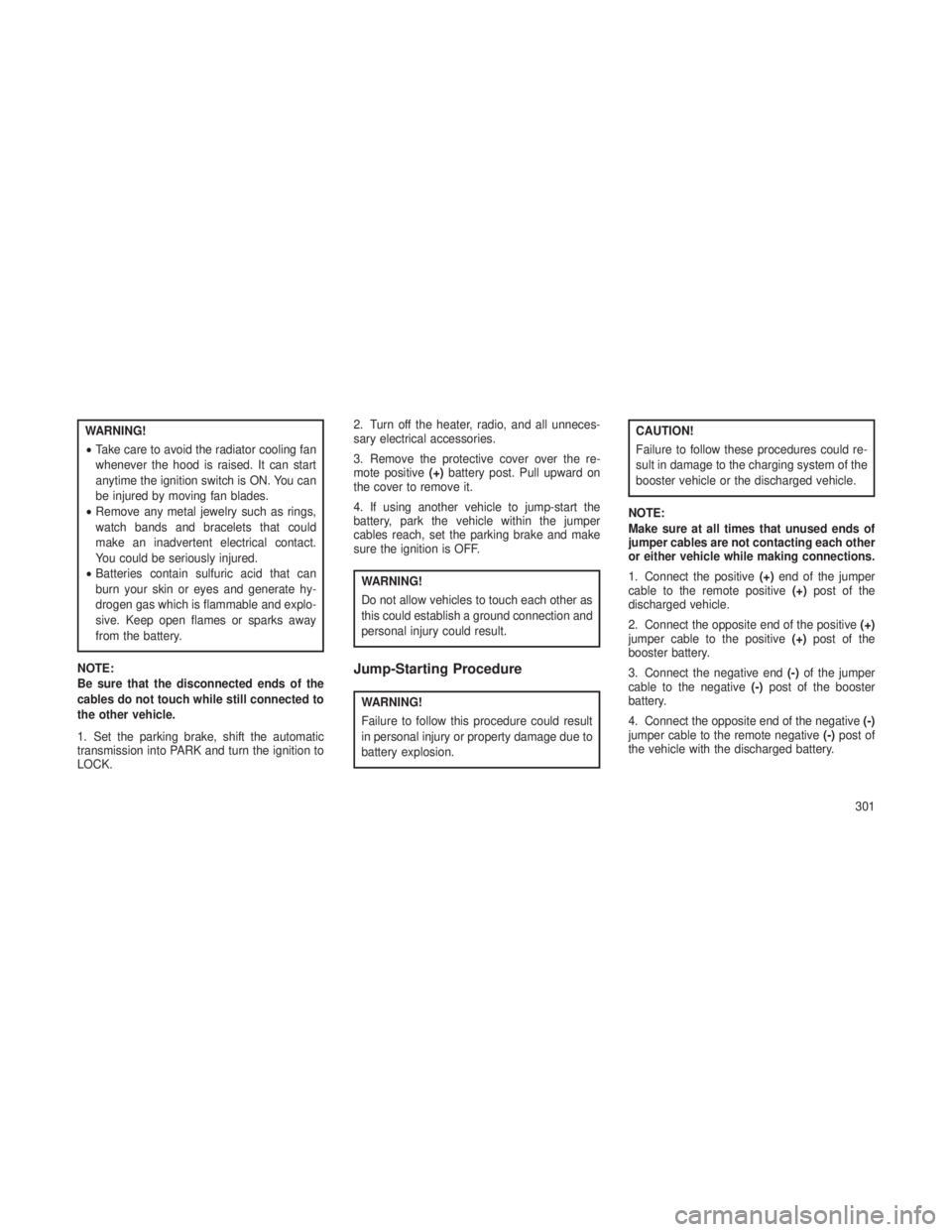
WARNING!
•Take care to avoid the radiator cooling fan
whenever the hood is raised. It can start
anytime the ignition switch is ON. You can
be injured by moving fan blades.
• Remove any metal jewelry such as rings,
watch bands and bracelets that could
make an inadvertent electrical contact.
You could be seriously injured.
• Batteries contain sulfuric acid that can
burn your skin or eyes and generate hy-
drogen gas which is flammable and explo-
sive. Keep open flames or sparks away
from the battery.
NOTE:
Be sure that the disconnected ends of the
cables do not touch while still connected to
the other vehicle.
1. Set the parking brake, shift the automatic
transmission into PARK and turn the ignition to
LOCK. 2. Turn off the heater, radio, and all unneces-
sary electrical accessories.
3. Remove the protective cover over the re-
mote positive
(+)battery post. Pull upward on
the cover to remove it.
4. If using another vehicle to jump-start the
battery, park the vehicle within the jumper
cables reach, set the parking brake and make
sure the ignition is OFF.
WARNING!
Do not allow vehicles to touch each other as
this could establish a ground connection and
personal injury could result.
Jump-Starting Procedure
WARNING!
Failure to follow this procedure could result
in personal injury or property damage due to
battery explosion.
CAUTION!
Failure to follow these procedures could re-
sult in damage to the charging system of the
booster vehicle or the discharged vehicle.
NOTE:
Make sure at all times that unused ends of
jumper cables are not contacting each other
or either vehicle while making connections.
1. Connect the positive (+)end of the jumper
cable to the remote positive (+)post of the
discharged vehicle.
2. Connect the opposite end of the positive (+)
jumper cable to the positive (+)post of the
booster battery.
3. Connect the negative end (-)of the jumper
cable to the negative (-)post of the booster
battery.
4. Connect the opposite end of the negative (-)
jumper cable to the remote negative (-)post of
the vehicle with the discharged battery.
301
Page 313 of 408
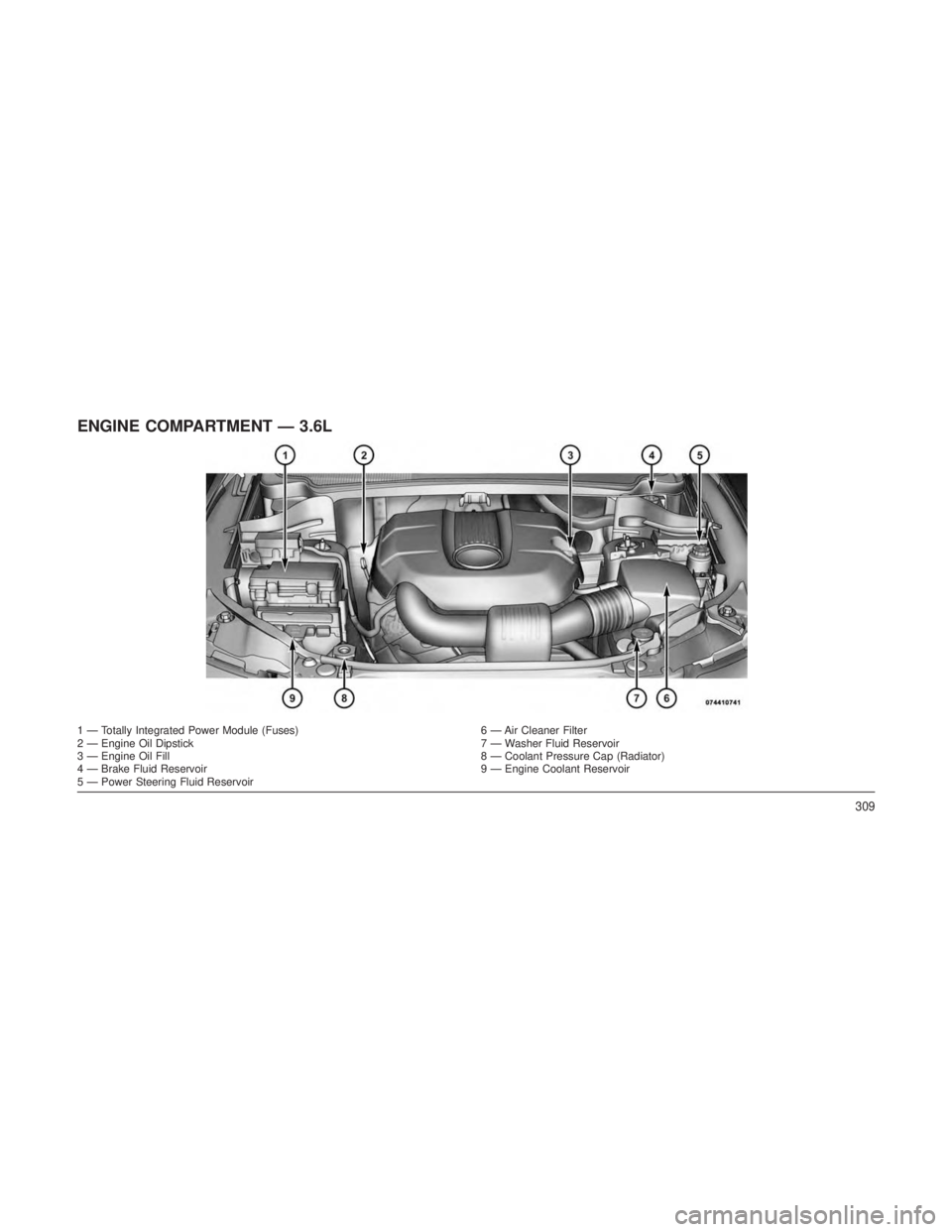
ENGINE COMPARTMENT — 3.6L
1 — Totally Integrated Power Module (Fuses)6 — Air Cleaner Filter
2 — Engine Oil Dipstick 7 — Washer Fluid Reservoir
3 — Engine Oil Fill 8 — Coolant Pressure Cap (Radiator)
4 — Brake Fluid Reservoir 9 — Engine Coolant Reservoir
5 — Power Steering Fluid Reservoir
309
Page 314 of 408
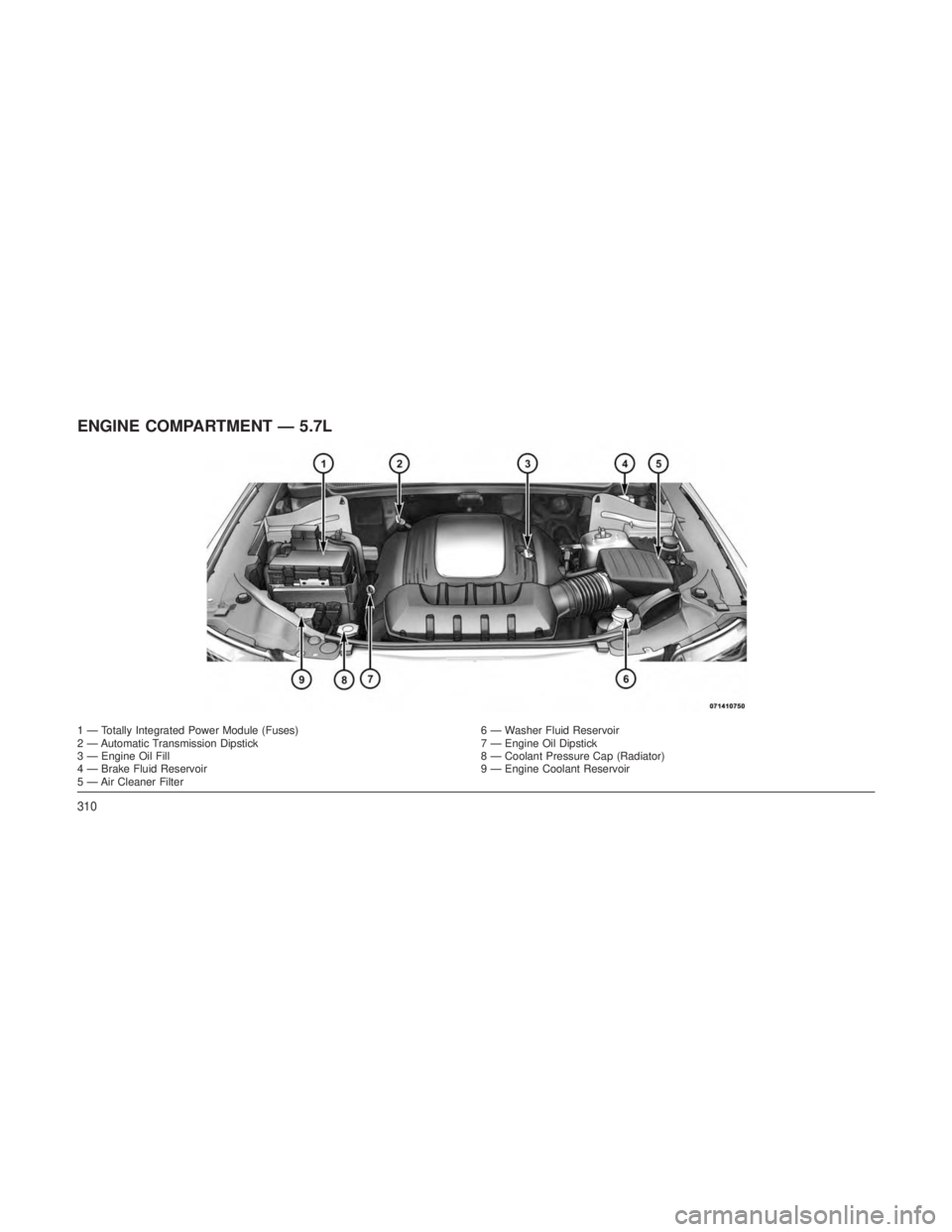
ENGINE COMPARTMENT — 5.7L
1 — Totally Integrated Power Module (Fuses)6 — Washer Fluid Reservoir
2 — Automatic Transmission Dipstick 7 — Engine Oil Dipstick
3 — Engine Oil Fill 8 — Coolant Pressure Cap (Radiator)
4 — Brake Fluid Reservoir 9 — Engine Coolant Reservoir
5 — Air Cleaner Filter
310
Page 323 of 408
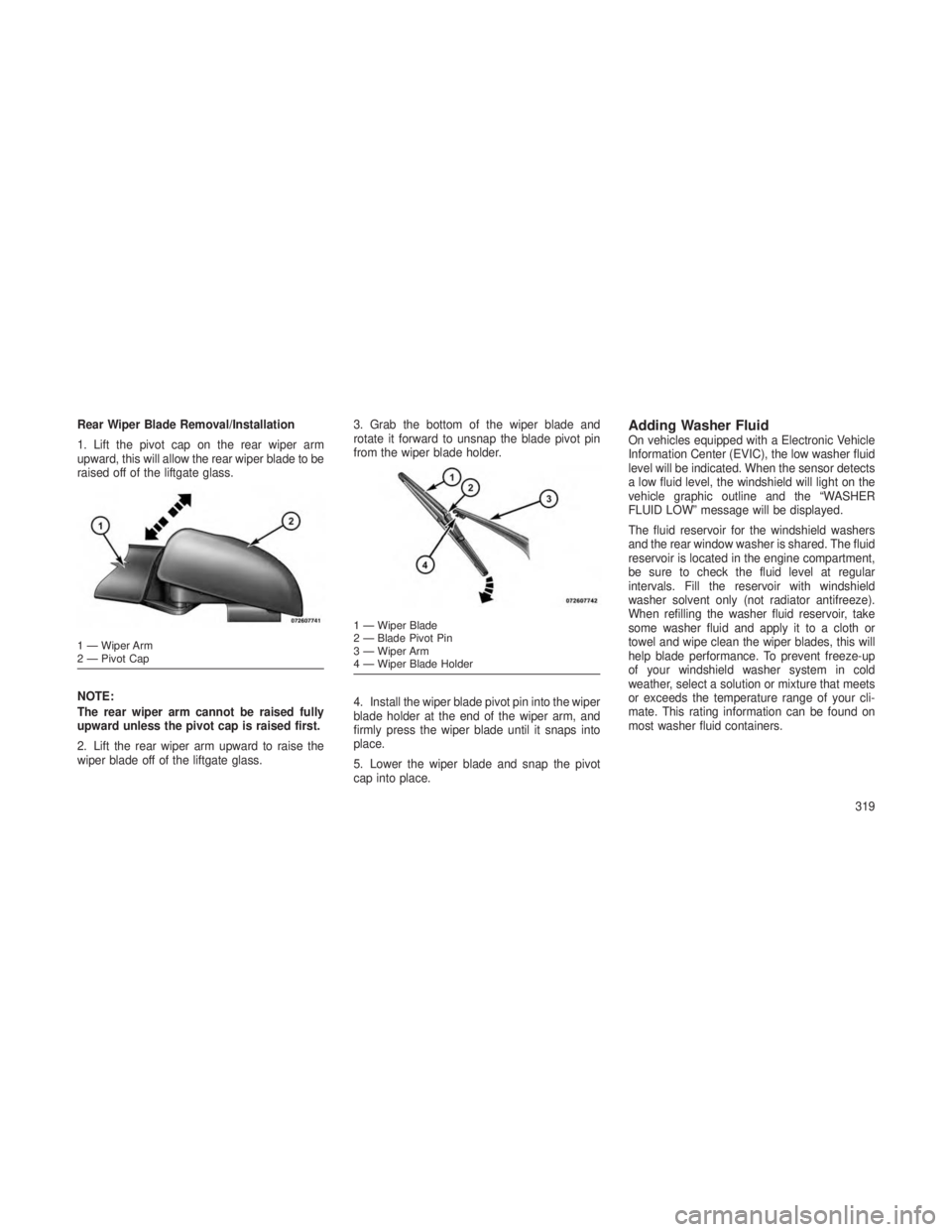
Rear Wiper Blade Removal/Installation
1. Lift the pivot cap on the rear wiper arm
upward, this will allow the rear wiper blade to be
raised off of the liftgate glass.
NOTE:
The rear wiper arm cannot be raised fully
upward unless the pivot cap is raised first.
2. Lift the rear wiper arm upward to raise the
wiper blade off of the liftgate glass.3. Grab the bottom of the wiper blade and
rotate it forward to unsnap the blade pivot pin
from the wiper blade holder.
4. Install the wiper blade pivot pin into the wiper
blade holder at the end of the wiper arm, and
firmly press the wiper blade until it snaps into
place.
5. Lower the wiper blade and snap the pivot
cap into place.Adding Washer FluidOn vehicles equipped with a Electronic Vehicle
Information Center (EVIC), the low washer fluid
level will be indicated. When the sensor detects
a low fluid level, the windshield will light on the
vehicle graphic outline and the “WASHER
FLUID LOW” message will be displayed.
The fluid reservoir for the windshield washers
and the rear window washer is shared. The fluid
reservoir is located in the engine compartment,
be sure to check the fluid level at regular
intervals. Fill the reservoir with windshield
washer solvent only (not radiator antifreeze).
When refilling the washer fluid reservoir, take
some washer fluid and apply it to a cloth or
towel and wipe clean the wiper blades, this will
help blade performance. To prevent freeze-up
of your windshield washer system in cold
weather, select a solution or mixture that meets
or exceeds the temperature range of your cli-
mate. This rating information can be found on
most washer fluid containers.
1 — Wiper Arm
2 — Pivot Cap
1 — Wiper Blade
2 — Blade Pivot Pin
3 — Wiper Arm
4 — Wiper Blade Holder
319
Page 325 of 408
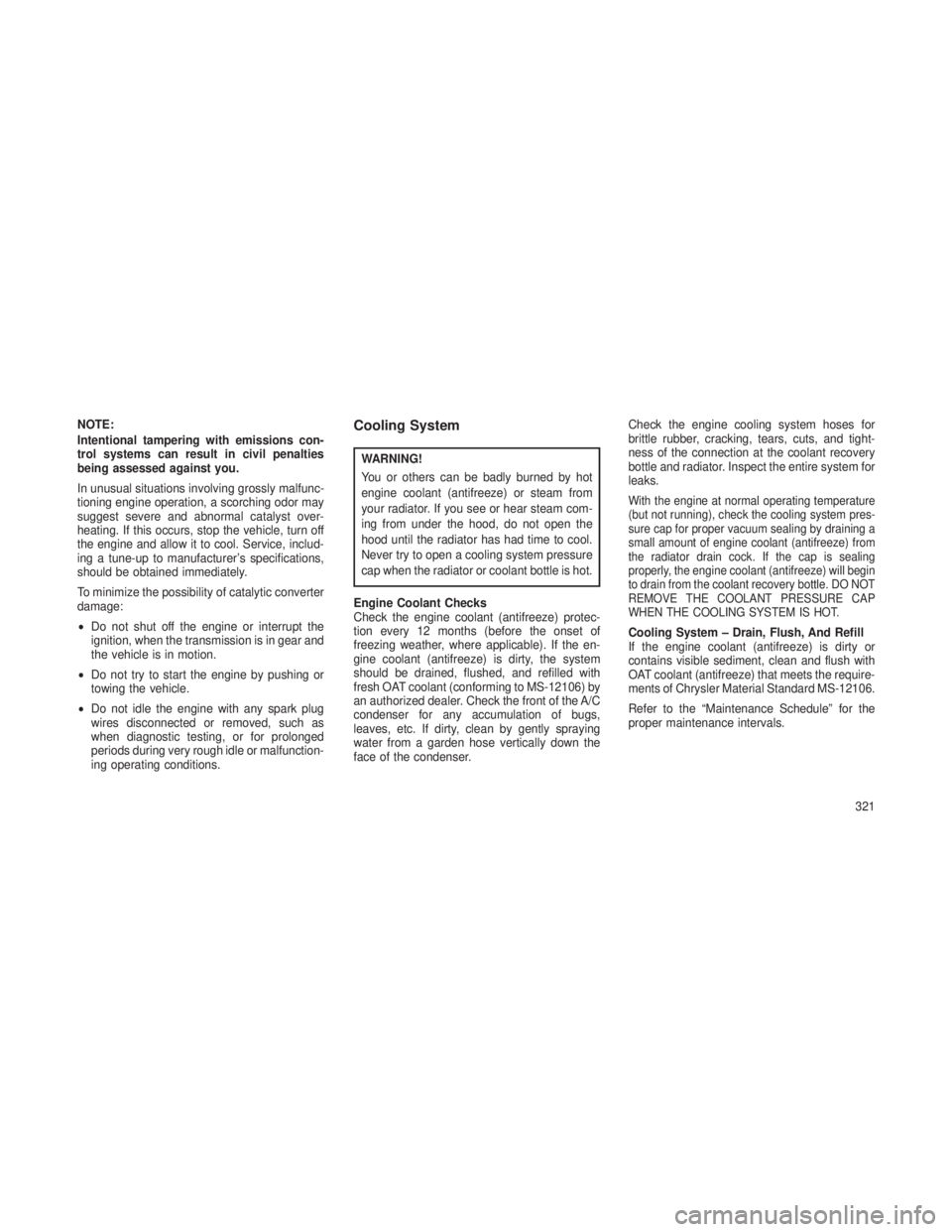
NOTE:
Intentional tampering with emissions con-
trol systems can result in civil penalties
being assessed against you.
In unusual situations involving grossly malfunc-
tioning engine operation, a scorching odor may
suggest severe and abnormal catalyst over-
heating. If this occurs, stop the vehicle, turn off
the engine and allow it to cool. Service, includ-
ing a tune-up to manufacturer’s specifications,
should be obtained immediately.
To minimize the possibility of catalytic converter
damage:
•Do not shut off the engine or interrupt the
ignition, when the transmission is in gear and
the vehicle is in motion.
• Do not try to start the engine by pushing or
towing the vehicle.
• Do not idle the engine with any spark plug
wires disconnected or removed, such as
when diagnostic testing, or for prolonged
periods during very rough idle or malfunction-
ing operating conditions.Cooling System
WARNING!
You or others can be badly burned by hot
engine coolant (antifreeze) or steam from
your radiator. If you see or hear steam com-
ing from under the hood, do not open the
hood until the radiator has had time to cool.
Never try to open a cooling system pressure
cap when the radiator or coolant bottle is hot.
Engine Coolant Checks
Check the engine coolant (antifreeze) protec-
tion every 12 months (before the onset of
freezing weather, where applicable). If the en-
gine coolant (antifreeze) is dirty, the system
should be drained, flushed, and refilled with
fresh OAT coolant (conforming to MS-12106) by
an authorized dealer. Check the front of the A/C
condenser for any accumulation of bugs,
leaves, etc. If dirty, clean by gently spraying
water from a garden hose vertically down the
face of the condenser. Check the engine cooling system hoses for
brittle rubber, cracking, tears, cuts, and tight-
ness of the connection at the coolant recovery
bottle and radiator. Inspect the entire system for
leaks.
With the engine at normal operating temperature
(but not running), check the cooling system pres-
sure cap for proper vacuum sealing by draining a
small amount of engine coolant (antifreeze) from
the radiator drain cock. If the cap is sealing
properly, the engine coolant (antifreeze) will begin
to drain from the coolant recovery bottle. DO NOT
REMOVE THE COOLANT PRESSURE CAP
WHEN THE COOLING SYSTEM IS HOT.
Cooling System – Drain, Flush, And Refill
If the engine coolant (antifreeze) is dirty or
contains visible sediment, clean and flush with
OAT coolant (antifreeze) that meets the require-
ments of Chrysler Material Standard MS-12106.
Refer to the “Maintenance Schedule” for the
proper maintenance intervals.
321
Page 326 of 408
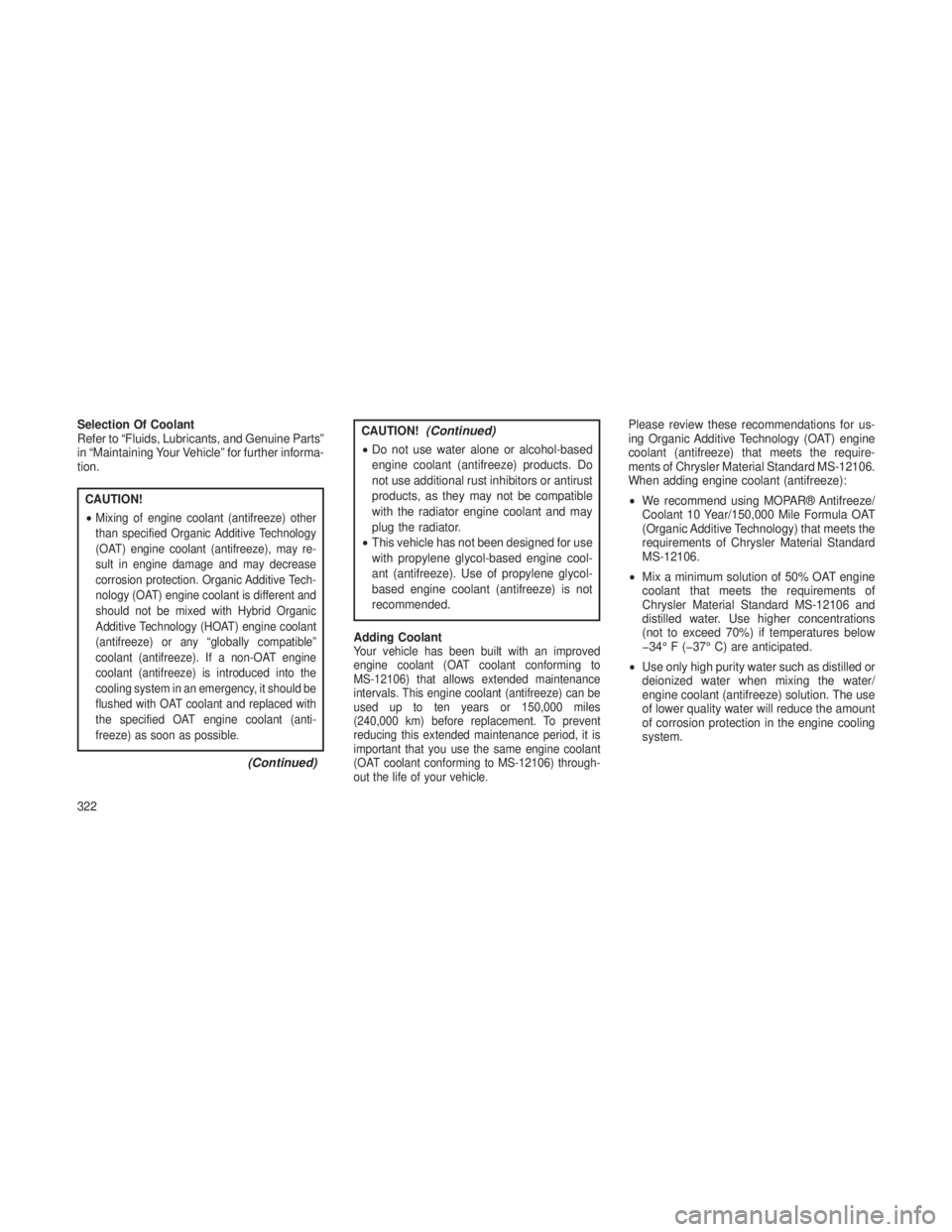
Selection Of Coolant
Refer to “Fluids, Lubricants, and Genuine Parts”
in “Maintaining Your Vehicle” for further informa-
tion.
CAUTION!
•
Mixing of engine coolant (antifreeze) other
than specified Organic Additive Technology
(OAT) engine coolant (antifreeze), may re-
sult in engine damage and may decrease
corrosion protection. Organic Additive Tech-
nology (OAT) engine coolant is different and
should not be mixed with Hybrid Organic
Additive Technology (HOAT) engine coolant
(antifreeze) or any “globally compatible”
coolant (antifreeze). If a non-OAT engine
coolant (antifreeze) is introduced into the
cooling system in an emergency, it should be
flushed with OAT coolant and replaced with
the specified OAT engine coolant (anti-
freeze) as soon as possible.
(Continued)
CAUTION!(Continued)
•Do not use water alone or alcohol-based
engine coolant (antifreeze) products. Do
not use additional rust inhibitors or antirust
products, as they may not be compatible
with the radiator engine coolant and may
plug the radiator.
• This vehicle has not been designed for use
with propylene glycol-based engine cool-
ant (antifreeze). Use of propylene glycol-
based engine coolant (antifreeze) is not
recommended.
Adding Coolant
Your vehicle has been built with an improved
engine coolant (OAT coolant conforming to
MS-12106) that allows extended maintenance
intervals. This engine coolant (antifreeze) can be
used up to ten years or 150,000 miles
(240,000 km) before replacement. To prevent
reducing this extended maintenance period, it is
important that you use the same engine coolant
(OAT coolant conforming to MS-12106) through-
out the life of your vehicle.
Please review these recommendations for us-
ing Organic Additive Technology (OAT) engine
coolant (antifreeze) that meets the require-
ments of Chrysler Material Standard MS-12106.
When adding engine coolant (antifreeze):
• We recommend using MOPAR® Antifreeze/
Coolant 10 Year/150,000 Mile Formula OAT
(Organic Additive Technology) that meets the
requirements of Chrysler Material Standard
MS-12106.
• Mix a minimum solution of 50% OAT engine
coolant that meets the requirements of
Chrysler Material Standard MS-12106 and
distilled water. Use higher concentrations
(not to exceed 70%) if temperatures below
�34° F (�37° C) are anticipated.
• Use only high purity water such as distilled or
deionized water when mixing the water/
engine coolant (antifreeze) solution. The use
of lower quality water will reduce the amount
of corrosion protection in the engine cooling
system.
322
Page 327 of 408
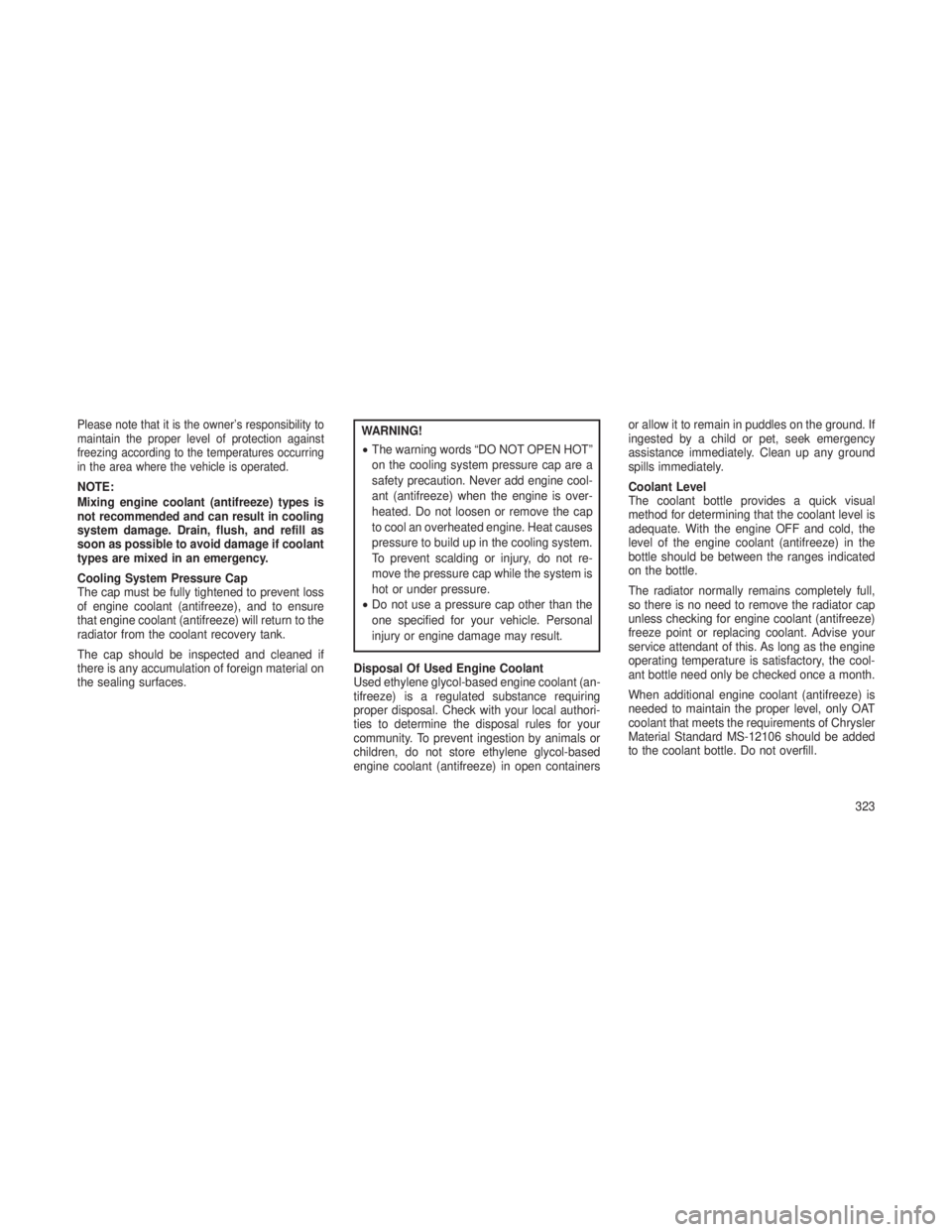
Please note that it is the owner’s responsibility to
maintain the proper level of protection against
freezing according to the temperatures occurring
in the area where the vehicle is operated.
NOTE:
Mixing engine coolant (antifreeze) types is
not recommended and can result in cooling
system damage. Drain, flush, and refill as
soon as possible to avoid damage if coolant
types are mixed in an emergency.
Cooling System Pressure Cap
The cap must be fully tightened to prevent loss
of engine coolant (antifreeze), and to ensure
that engine coolant (antifreeze) will return to the
radiator from the coolant recovery tank.
The cap should be inspected and cleaned if
there is any accumulation of foreign material on
the sealing surfaces.
WARNING!
•The warning words “DO NOT OPEN HOT”
on the cooling system pressure cap are a
safety precaution. Never add engine cool-
ant (antifreeze) when the engine is over-
heated. Do not loosen or remove the cap
to cool an overheated engine. Heat causes
pressure to build up in the cooling system.
To prevent scalding or injury, do not re-
move the pressure cap while the system is
hot or under pressure.
• Do not use a pressure cap other than the
one specified for your vehicle. Personal
injury or engine damage may result.
Disposal Of Used Engine Coolant
Used ethylene glycol-based engine coolant (an-
tifreeze) is a regulated substance requiring
proper disposal. Check with your local authori-
ties to determine the disposal rules for your
community. To prevent ingestion by animals or
children, do not store ethylene glycol-based
engine coolant (antifreeze) in open containers or allow it to remain in puddles on the ground. If
ingested by a child or pet, seek emergency
assistance immediately. Clean up any ground
spills immediately.
Coolant Level
The coolant bottle provides a quick visual
method for determining that the coolant level is
adequate. With the engine OFF and cold, the
level of the engine coolant (antifreeze) in the
bottle should be between the ranges indicated
on the bottle.
The radiator normally remains completely full,
so there is no need to remove the radiator cap
unless checking for engine coolant (antifreeze)
freeze point or replacing coolant. Advise your
service attendant of this. As long as the engine
operating temperature is satisfactory, the cool-
ant bottle need only be checked once a month.
When additional engine coolant (antifreeze) is
needed to maintain the proper level, only OAT
coolant that meets the requirements of Chrysler
Material Standard MS-12106 should be added
to the coolant bottle. Do not overfill.
323
Page 328 of 408
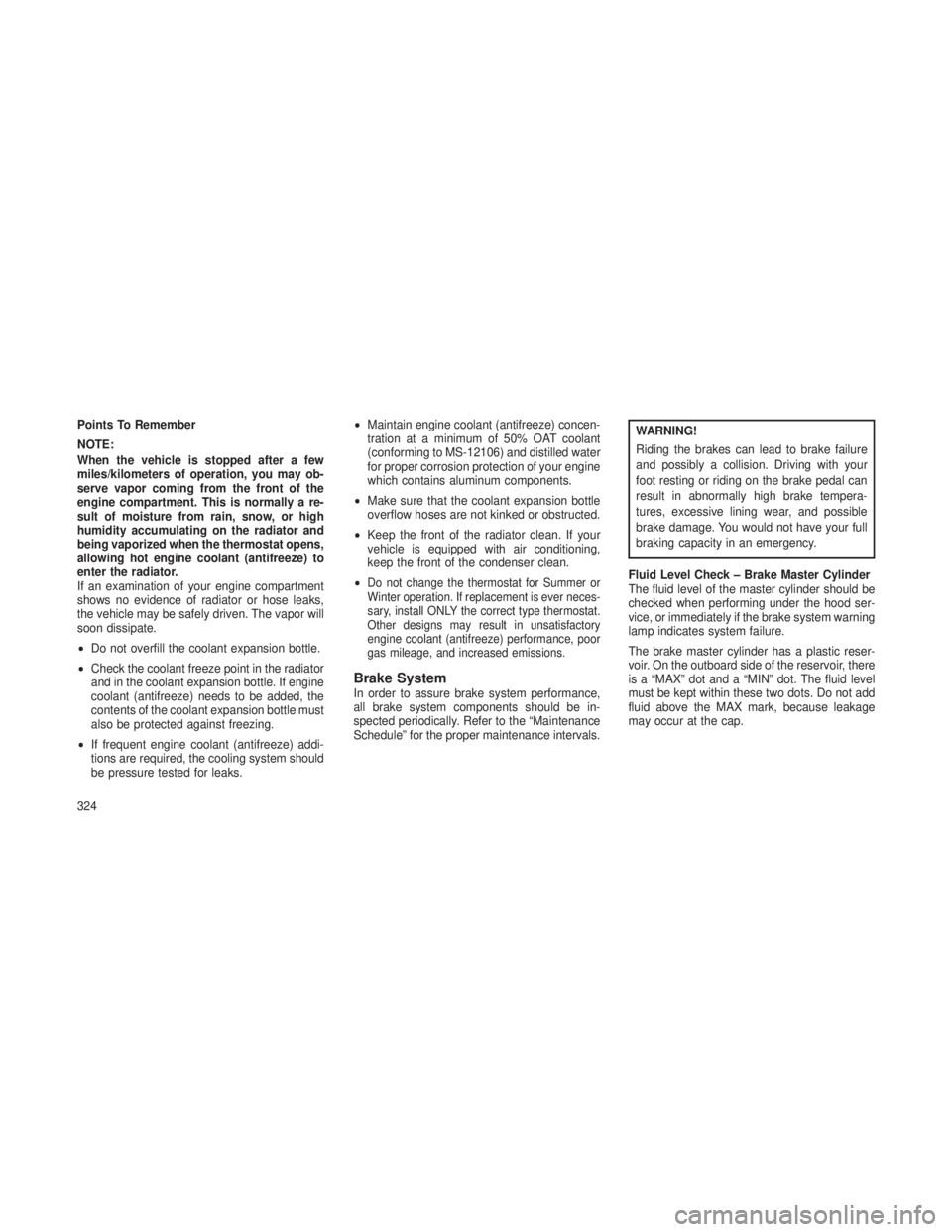
Points To Remember
NOTE:
When the vehicle is stopped after a few
miles/kilometers of operation, you may ob-
serve vapor coming from the front of the
engine compartment. This is normally a re-
sult of moisture from rain, snow, or high
humidity accumulating on the radiator and
being vaporized when the thermostat opens,
allowing hot engine coolant (antifreeze) to
enter the radiator.
If an examination of your engine compartment
shows no evidence of radiator or hose leaks,
the vehicle may be safely driven. The vapor will
soon dissipate.
•Do not overfill the coolant expansion bottle.
• Check the coolant freeze point in the radiator
and in the coolant expansion bottle. If engine
coolant (antifreeze) needs to be added, the
contents of the coolant expansion bottle must
also be protected against freezing.
• If frequent engine coolant (antifreeze) addi-
tions are required, the cooling system should
be pressure tested for leaks. •
Maintain engine coolant (antifreeze) concen-
tration at a minimum of 50% OAT coolant
(conforming to MS-12106) and distilled water
for proper corrosion protection of your engine
which contains aluminum components.
• Make sure that the coolant expansion bottle
overflow hoses are not kinked or obstructed.
• Keep the front of the radiator clean. If your
vehicle is equipped with air conditioning,
keep the front of the condenser clean.
•
Do not change the thermostat for Summer or
Winter operation. If replacement is ever neces-
sary, install ONLY the correct type thermostat.
Other designs may result in unsatisfactory
engine coolant (antifreeze) performance, poor
gas mileage, and increased emissions.
Brake SystemIn order to assure brake system performance,
all brake system components should be in-
spected periodically. Refer to the “Maintenance
Schedule” for the proper maintenance intervals.
WARNING!
Riding the brakes can lead to brake failure
and possibly a collision. Driving with your
foot resting or riding on the brake pedal can
result in abnormally high brake tempera-
tures, excessive lining wear, and possible
brake damage. You would not have your full
braking capacity in an emergency.
Fluid Level Check – Brake Master Cylinder
The fluid level of the master cylinder should be
checked when performing under the hood ser-
vice, or immediately if the brake system warning
lamp indicates system failure.
The brake master cylinder has a plastic reser-
voir. On the outboard side of the reservoir, there
is a “MAX” dot and a “MIN” dot. The fluid level
must be kept within these two dots. Do not add
fluid above the MAX mark, because leakage
may occur at the cap.
324